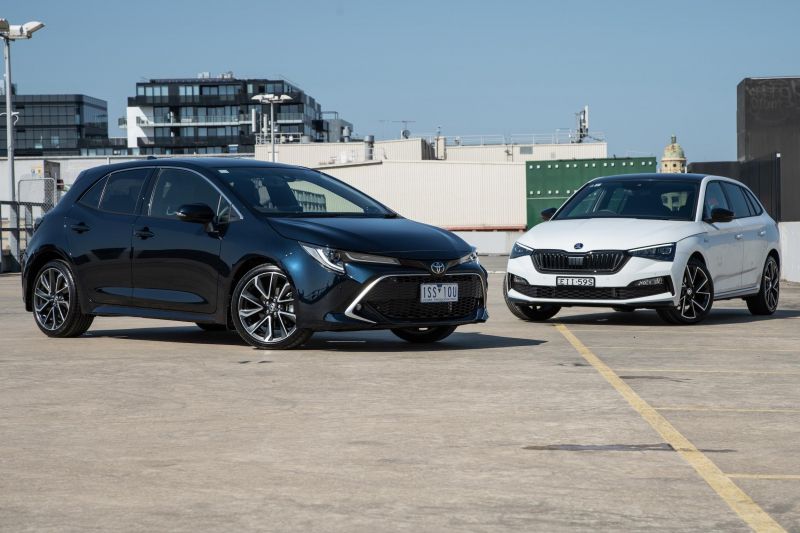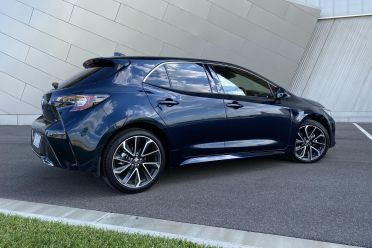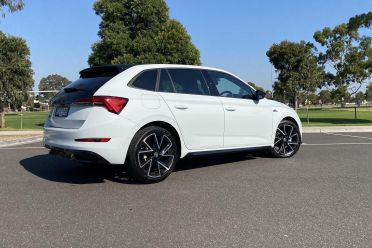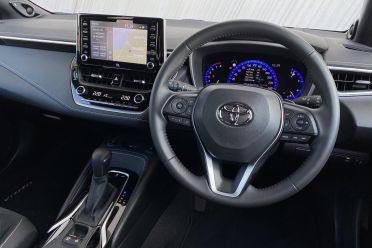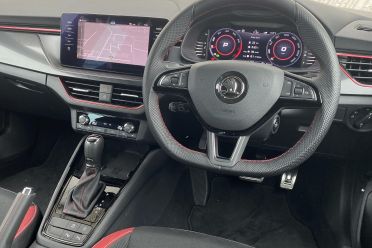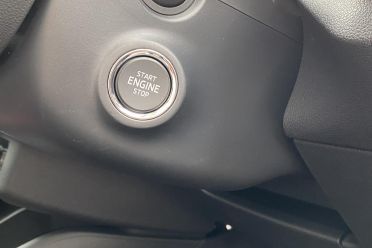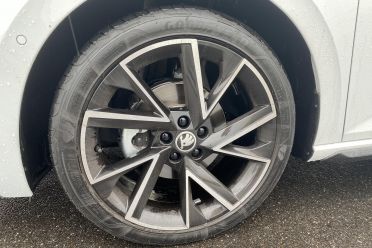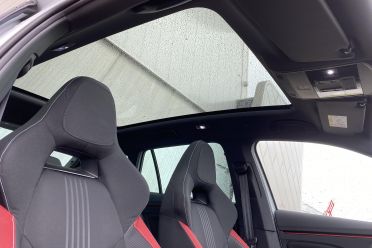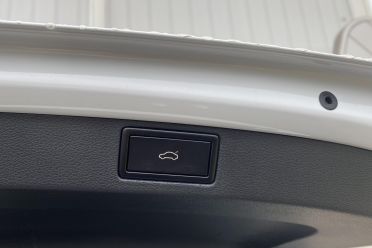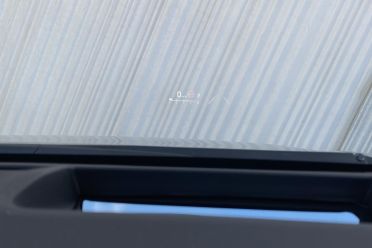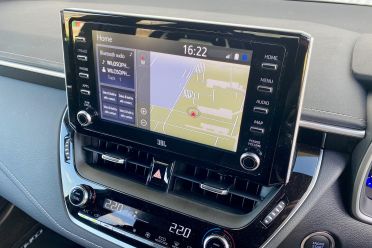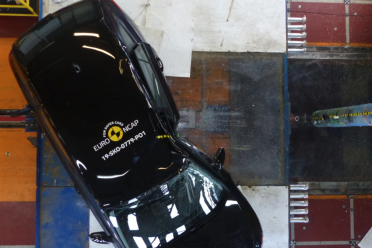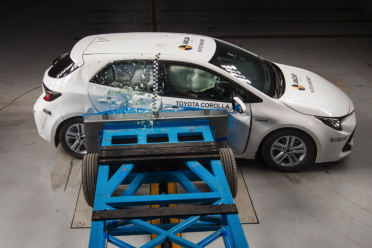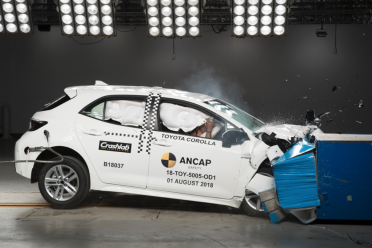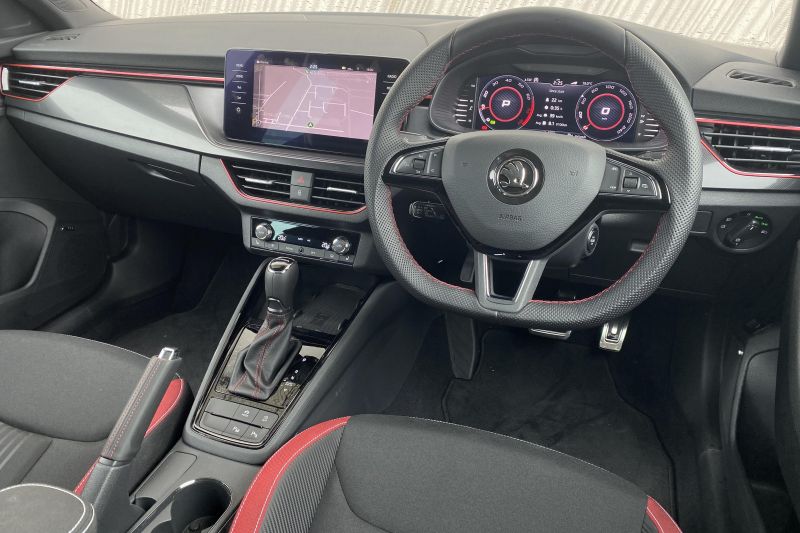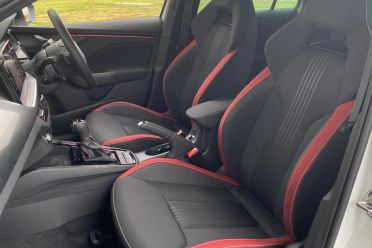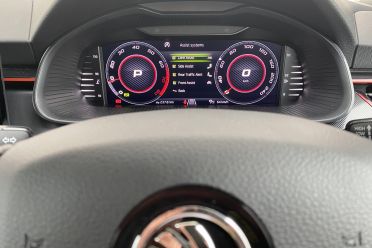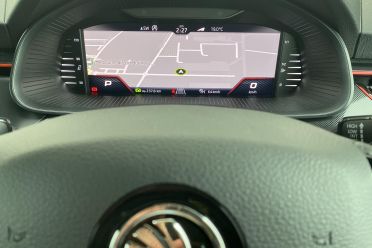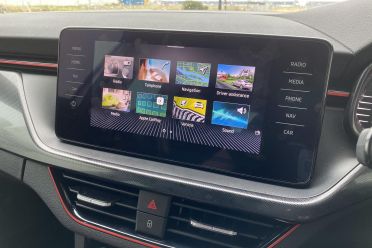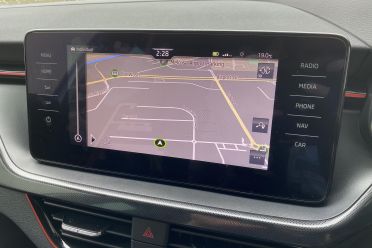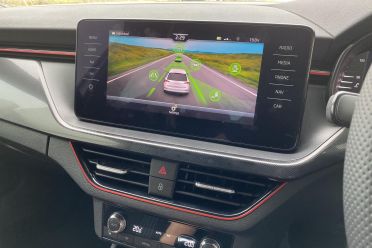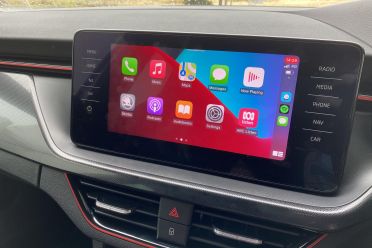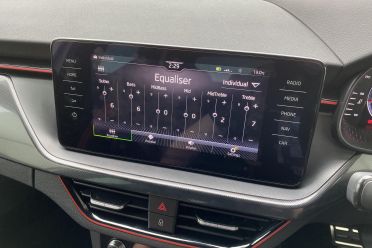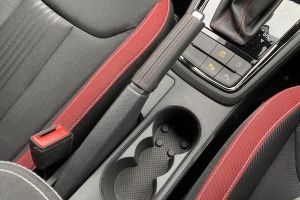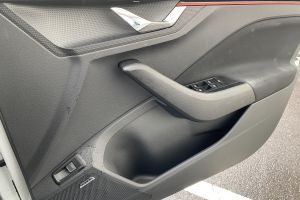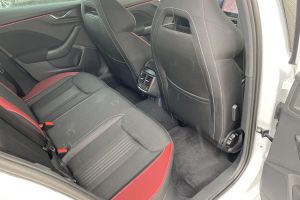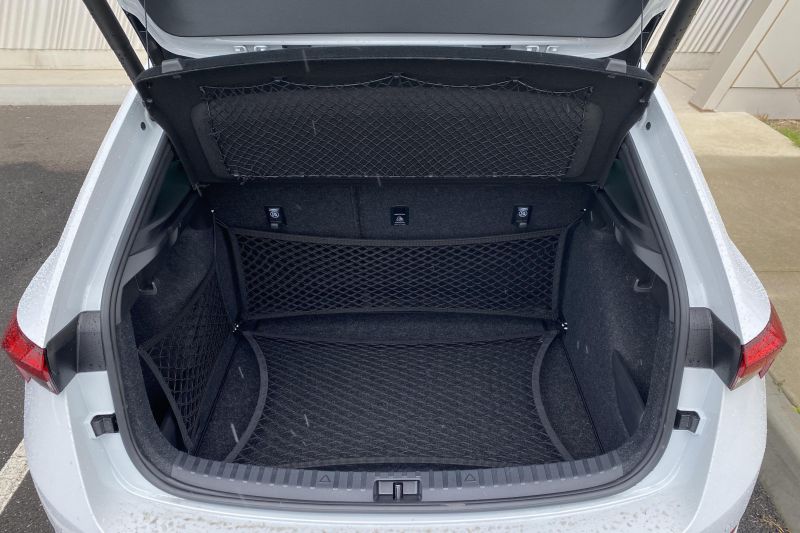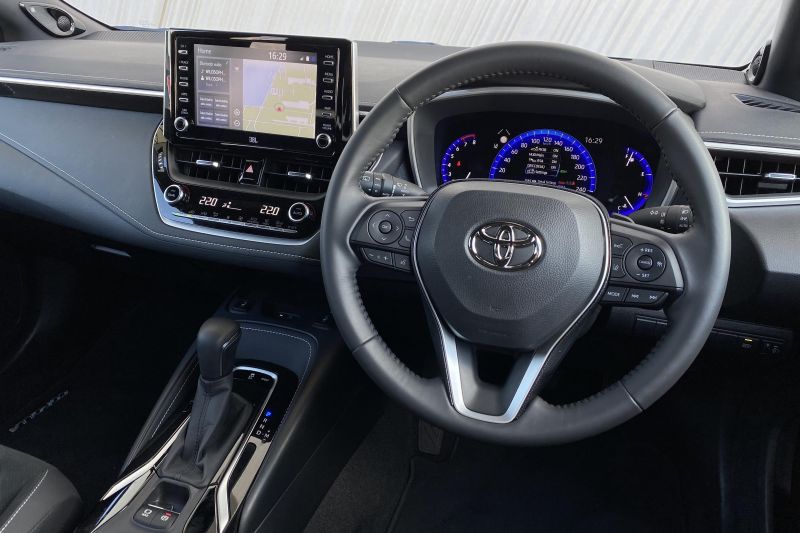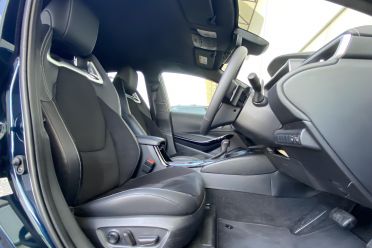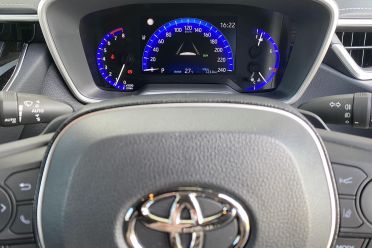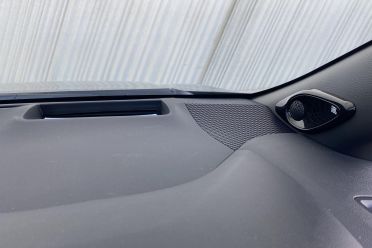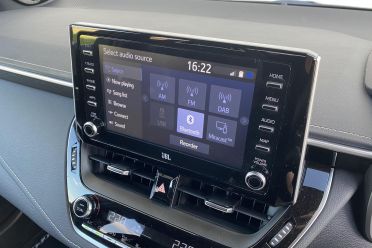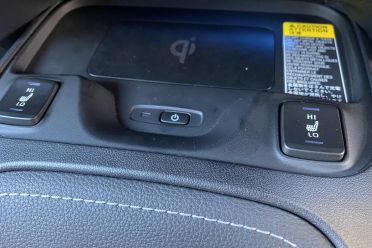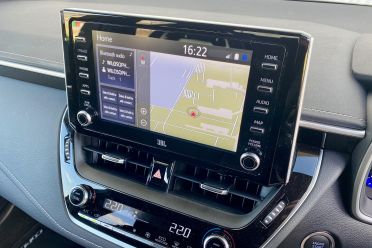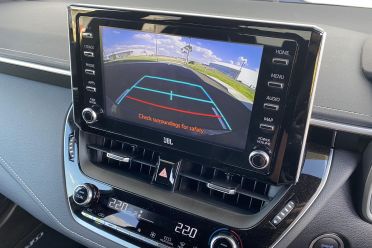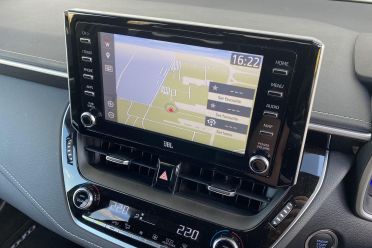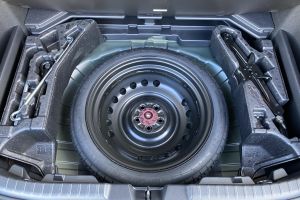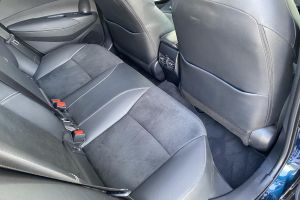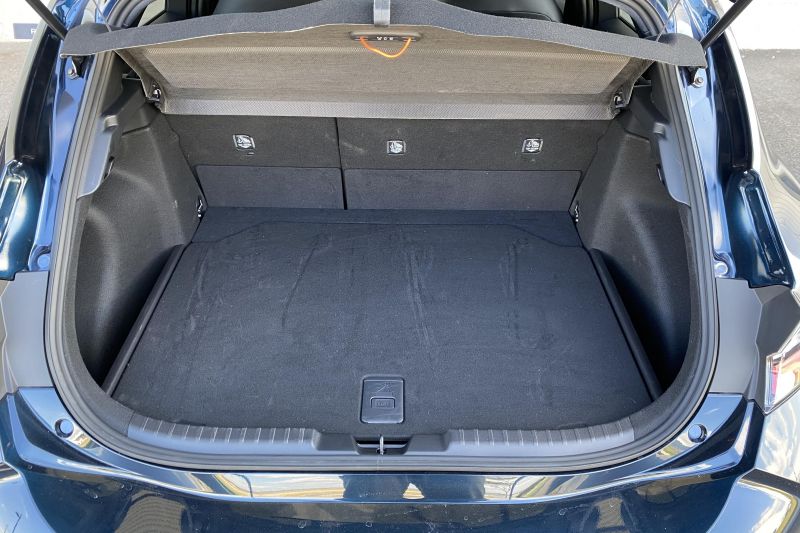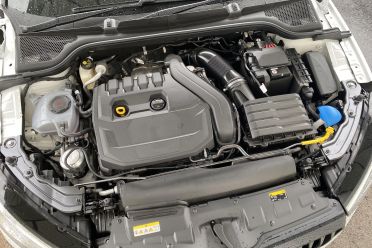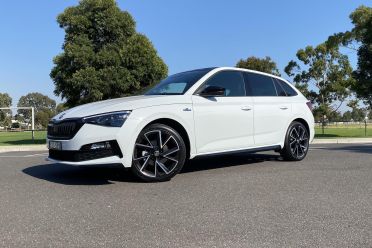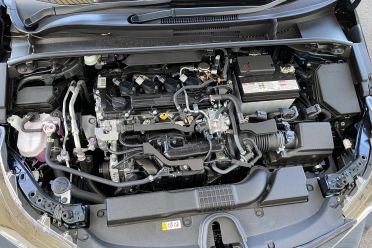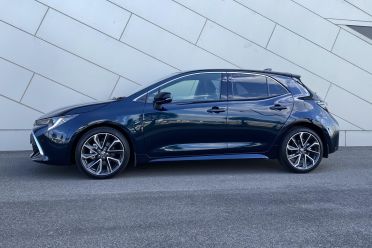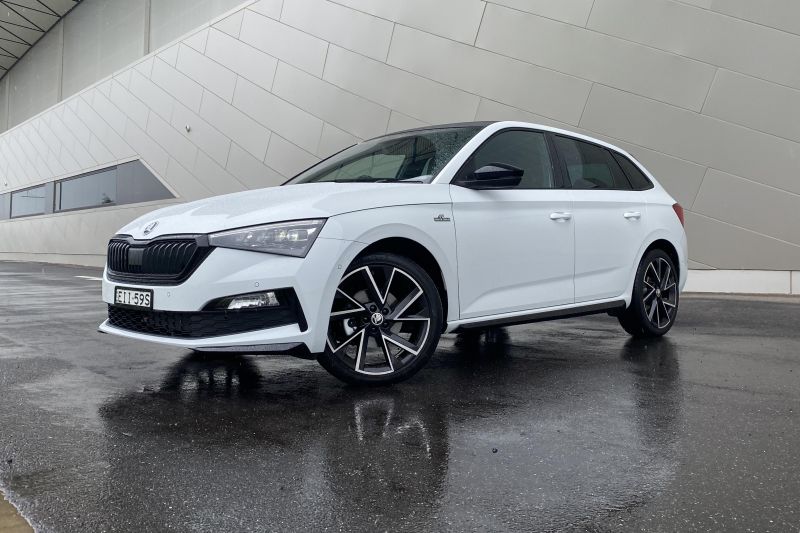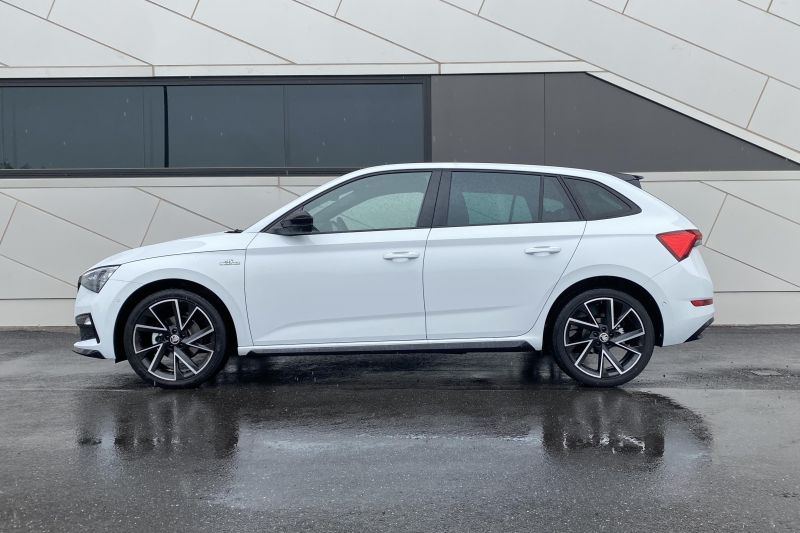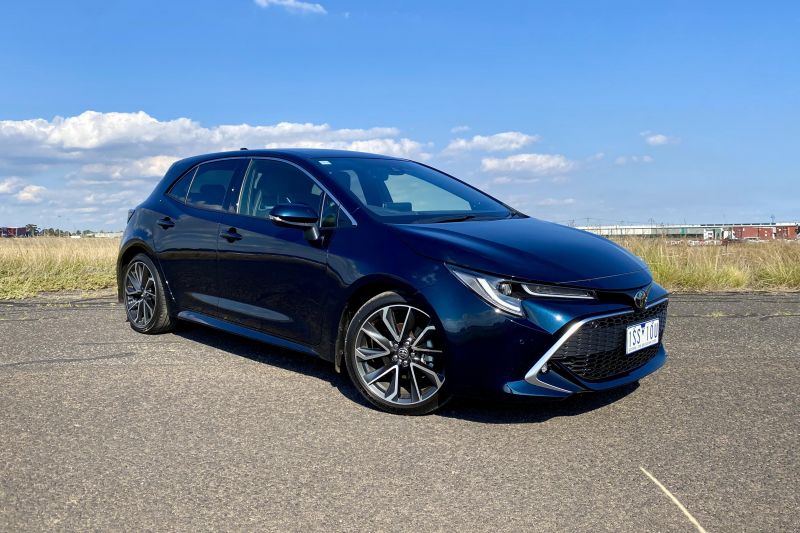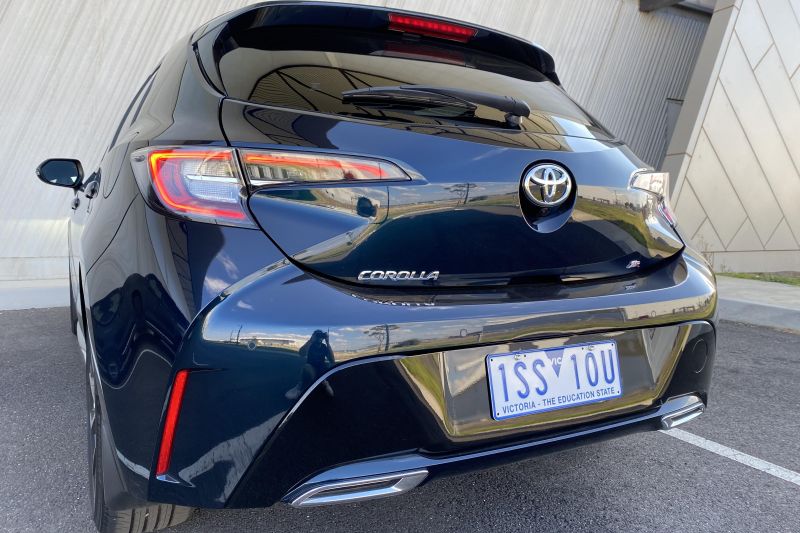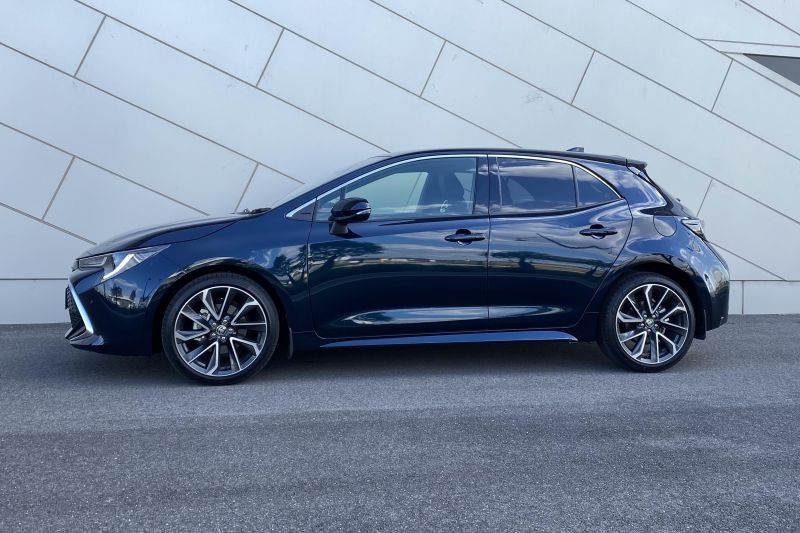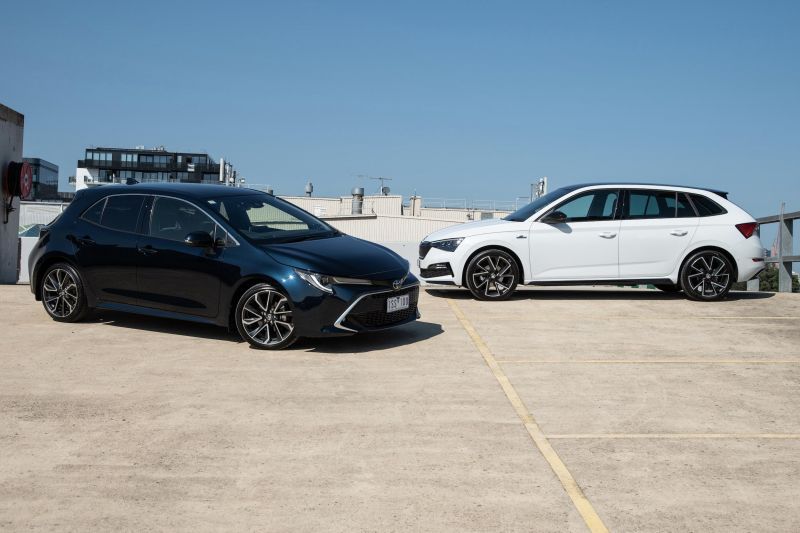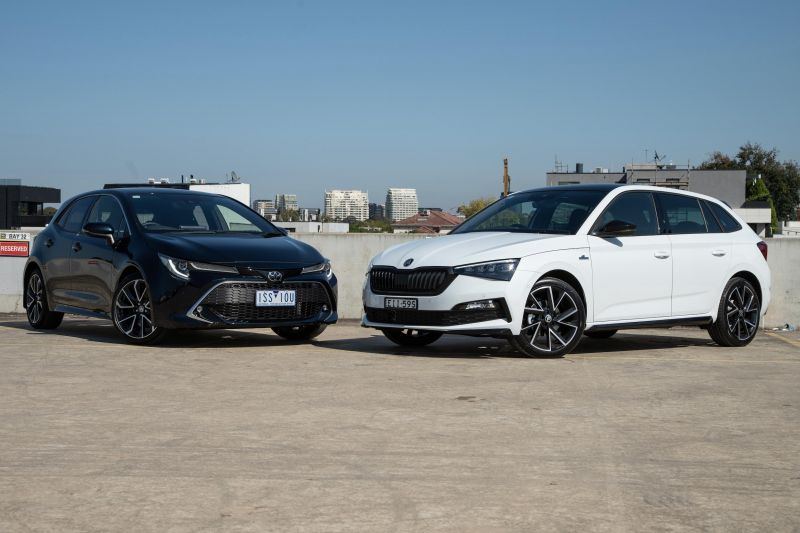The Skoda Scala and Toyota Corolla small hatchbacks make an interesting comparison test in more ways than one.
Of course, they’re both hatchbacks with similar dimensions and pricing. But they’re also defined by the very different spots they occupy on the average consumer’s awareness lists.
The Toyota is Australia’s single top-selling passenger car and has been a dominant player for decades. Everybody knows what a Corolla is.
The Skoda on the other hand is a more niche offering fighting for awareness in a bustling market segment dominated by Japanese and Korean brands.
Should Corolla buyers be looking beyond the mainstream? Does the Skoda conquer a class favourite?
How much?
These range-toppers are reasonably priced all things considered.
The Skoda Scala Monte Carlo costs $33,990 drive-away ($33,390 list price or MSRP), whereas the Toyota Corolla ZR costs about $36,900 drive-away depending on your State of residence ($32,695 list price or MSRP).
Toyota charges $500 for metallic paint, while Skoda charges $550. The Skoda as tested also came with an optional travel package that I’ll detail in a sec.
As such, the drive-away prices of our two test cars are about $37,500 for the Corolla ZR and $38,840 for the Scala Monte Carlo.
| Skoda Scala | Toyota Corolla | |
|---|---|---|
| Variant | Monte Carlo | ZR |
| List price or MSRP | $33,390 | $32,695 |
| Expected drive-away price | $33,990 | $36,916 (Vic) |
| As tested with options | $38,840 | $37,517 (Vic) |
What do you get?
Equipment common to both includes LED headlights, tail lights and daytime running lights; proximity key access with button start, 18-inch alloy wheels, power-folding side mirrors, auto wipers, and rear privacy glass.
Inside, each comes with an auto-dimming rear-view mirror, climate control with two zones, an 8.0-inch touchscreen, Apple CarPlay and Android Auto, and a reversing camera.
The Toyota Corolla ZR exclusively offers leather and suede seat trim instead of fabric, heated front seats with driver’s side power adjustment, a head-up display, DAB+ digital radio;, and factory satellite-navigation.
The Skoda counters wth exclusive glass roof, powered tailgate, a fully digital instrument display, and USB-C points rather than regular USBs.
The Skoda’s fitted Travel package adds a lot of desirable extras, including:
A 9.2-inch touchscreen with satellite navigation, wireless CarPlay, heated seats for front and rear occupants, a boosted sound system, voice control, paddle shifters, blind-spot monitoring, rear-traffic alert, and auto parking assist.
| Skoda Scala | Toyota Corolla | |
|---|---|---|
| LED headlights | Standard | Standard |
| LED tail lights | Standard | Standard |
| LED day lights | Standard | Standard |
| Proximity key | Standard | Standard |
| Roof | Glass | Steel |
| 18-inch wheels | Standard | Standard |
| Auto side mirrors | Standard | Standard |
| Rear privacy glass | Standard | Standard |
| Powered tailgate | Standard | – |
| Seat trim | Fabric | Leather, suede |
| Driver seat | Manual | Powered, heated |
| Auto-dimming rear-view mirror | Standard | Standard |
| Instrument cluster | Fully digital | Part digital |
| Head-up display | – | Standard |
| Climate control | Standard | Standard |
| 8.0-inch touchscreen | Standard | Standard |
| 9.2-inch touchscreen | Option | – |
| Sat-nav | Option | Standard |
| Digital radio | – | Standard |
| Charge ports | 2 x USB-C | 2 x USB |
| Apple CarPlay | Standard | Standard |
| Android Auto | Standard | Standard |
| Reverse camera | Standard | Standard |
| Options | Travel Pack: | – |
Are they safe?
Independent (part-government-backed) crash tester ANCAP awarded the Skoda a five-star rating in 2019 thanks to scores of 97 per cent for adult protection, 87 per cent for child safety, 81 per cent for vulnerable road-user protection, and 76 per cent for safety assist.
ANCAP also awarded the Corolla hatch the maximum five stars, with a slightly earlier 2018 date stamp. The Toyota scored 96 per cent for adult protection, 83 per cent for child safety, 86 per cent for vulnerable road-user protection, and 76 per cent for safety assist.
Rather than reading about efficacy of each car’s passive and active safety systems here, go have a read of the lab reports for the Skoda here, and Toyota here.
Both cars come with seven airbags, rear ISOFIX and top testers for child seats, autonomous emergency braking (AEB) systems, lane-keeping aids, active cruise control, and driver-fatigue monitors.
But only the Corolla comes with standard lane-centring aid, blind-spot monitoring and rear cross-traffic alert.
The latter two functions can be optioned on the Skoda as part of the Travel pack, and the Scala also get a multi-collision brake system to stop you cannoning forwards in secondary rear impacts.
| Skoda | Toyota | |
|---|---|---|
| Airbags | 7 | 7 |
| ISOFIX and top tethers | Standard | Standard |
| AEB | Standard | Standard |
| Lane-keeping assist | Standard | Standard |
| Lane-centring assistant | – | Standard |
| Rear cross-traffic alert | Option | Standard |
| Blind-spot monitor | Option | Standard |
| Active cruise control | Standard | Standard |
| Rear camera | Standard | Standard |
| Driver monitor | Standard | Standard |
| Multi-collision brake | Standard | – |
What are they like inside?
Skoda Scala:
The Monte Carlo spec brings some sporty design elements; specifically the bright red dash trimmings, stitching, fabric, and ambient lighting. Build quality is excellent too, though it’s not particularly plush or premium in feel.
You get plenty of steering wheel adjustment, and the (manually adjusting) single-piece-backrest seats are supportive without being uncomfortable. The big glass roof and large side windows let a lot of light in.
The instrument cluster is displayed on a fully digital 10.25-inch display called ‘Virtual Cockpit’, and can show you a full-size map and various dial designs. The Corolla’s part-digital and part-analogue layout doesn’t look as modern or slick.
The standard centre touchscreen measures eight inches and supports Apple CarPlay and Android Auto. But because our test car had the optional Travel Pack, it had a larger 9.2-inch touch- and gesture-sensing screen screen flanked by shortcut touchpads.
It’s a great system that packages slick integrated maps, and various crisply animated menus to control audio, phone, active safety, and sound settings. It also allows pinching and zooming much like a phone.
Storage and practicality is typically a Skoda strength and the Scala doesn’t deviate. There are big door bins, a decent glovebox, and an open area below the centre fascia with a wireless phone charger (matching the Corolla).
Where the Scala really shows an advantage over the Corolla, and most small hatchbacks (Honda Civic being one obvious exception), is the back seating row, which offered sufficient legroom for me at 194cm, and decent headroom despite the glass roof.
Like the Corolla, the Scala offers rear air vents, but it also comes with two extra USB-C points. It’s all rather family-SUV-like for a small hatchback… The heated rear outboard seats on our test car are part of that optional Travel Pack.
The discrepancy in boot size is enormous,: the Scala is unusually capacious at 467 litres and the Corolla is smallest-in-class at 217L. The average for cars in this part of the market sits between 300L and 400L.
The boost also has multiple handy stretchable nets, sturdy bag hooks, and LED lighting. The tailgate is also powered, so you only need to touch a button to operate it. There’s a space-saver spare under the floor.
Toyota Corolla:
The basics are particularly (and typically) well covered, and it’s all put together flawlessly with hardy and well-chosen materials. It feels solid and cohesive, and is clearly more understated than the lairy Skoda. It has more universal appeal.
The shapely bucket seats have softer trim and the driver gets power adjustment. I also prefer the tactility of its steering wheel and buttons over the dimpled Skoda unit. Both cars have paddle shifters but only the Corolla’s are standard.
The basic analogue gauges flank a large and legible trip computer which nevertheless offers fewer variations than the Skoda Virtual Cockpit, but the Corolla’s sensational colour head-up display on the windscreen makes up for it.
The centre touchscreen is mounted similarly high in your eyeline and uses real buttons for shortcuts. The maps are nice and clear, there’s phone mirroring, and your home screen has various tiles that can be modified to suit your tastes.
Toyota’s infotainment is quite basic though, for instance you can’t use your fingers to swipe/pinch/zoom as smoothly. But it covers the fundamentals well enough. The JBL audio system is also the superior standard-fit unit.
Cabin storage is a little limited. There’s a decent glovebox and door bins, and cupholders, but also a small centre console and less storage along the centre tunnel. However it does have an electric parking brake with Auto Hold unlike the Skoda with its older-style pull-up hydraulic hand brake.
The Skoda-matching charging pad below the fascia is a good touch, though the placement of the seat-heater buttons right before it means you hit them all the time by mistake. Well, this writer did anyway.
Where the Corolla falls over a little is the back seats, which offer notably less legroom than the Skoda. Most adults will fit, but it’s all a little cosier than the norm on account of its packaging, and the side windows let less light in.
The boot is really unforgivably small, at just 217 litres with the temporary spare wheel below the loading floor. The ZR hybrid with a tyre-repair kit can stow 333L, but I’d be wanting a spare personally. If you need more storage then the Corolla sedan is always there, and able to stow 470L.
| Skoda Scala | Toyota Corolla | |
|---|---|---|
| Length | 4362mm | 4375mm |
| Width | 1793mm | 1790mm |
| Height | 1471mm | 1435mm |
| Wheelbase | 2649mm | 2640mm |
| Boot capacity | 467L | 217L |
What’s under the bonnet?
Skoda Scala:
All Scala grades use a 1.5-litre turbo-petrol engine – incidentally, a next-generation of the engine used in the ostensibly more premium Volkswagen Golf – making 110kW of power at 6000rpm and 250Nm of torque between 1500 and 3500rpm.
The engine is mated to a seven-speed DSG (dry) dual-clutch automatic transmission designed to rifle through ratios quickly.
It’s front-wheel drive. Skoda claims combined-cycle fuel economy of just 5.5 litres per 100km, which is 0.5L/100km superior to the Toyota. However unlike the Corolla the Skoda requires premium 95 RON fuel.
Toyota Corolla:
The base engine across all Corolla grades is a 2.0-litre ‘Dynamic Force’ naturally aspirated four-cylinder petrol unit making 125kW of power at 6600rpm and 200Nm of torque between 4400 and 4800rpm.
Toyota’s 2.0-litre is mated to a CVT automatic transmission with a novel mechanical launch gear to make it snappier off the mark, and 10 sequential shift points to make it feel more like a conventional torque-converter-style automatic.
It’s standard as front-wheel drive. Toyota claims combined-cycle fuel consumption of 6.0 litres per 100km, and it’ll run on basic 91 RON petrol.
By the way, the $2000 pricier Toyota Corolla hybrid cuts 91 RON fuel use to 4.2L/100km. Assuming a fuel price of $1.50 per litre, that’s $2.70 saved for every 100km driven, meaning you’d pay back the difference in about 75,000km.
| Skoda Scala | Toyota Corolla | |
|---|---|---|
| Petrol type | 95 RON | 91 RON |
| Displacement | 1.5-litre | 2.0-litre |
| Induction | Turbocharged | Naturally aspirated |
| Power | 110kW @ 6000rpm | 125kW @ 6600rpm |
| Torque | 250Nm @ 1500-3500rpm | 200Nm @ 4400-4800rpm |
| Driven wheels | Front | Front |
| Transmission | 7-speed DSG | CVT |
| Fuel economy | 5.5L/100km | 6.0L/100km |
| 0-100km/h as tested | 8.8 seconds | 9.6 seconds |
How do they drive?
Skoda Scala:
Volkswagen does small-displacement turbocharged petrol engines really well and this Scala’s unit is no exception.
The factory claim for a 0-100km/h dash is 8.3 seconds though its hard to carry revs and get off the line smoothly with the DSG. As such the best I managed in my three runs was 8.8 seconds. Still, eight-tenths quicker than the ‘Rolla.
Where the Corolla has instant response but needs revs to get places in haste (dulling refinement), the Scala takes fractions of a second to get rolling but is punchy, muscular, and refined once moving. It feels effortless under throttle.
My fuel consumption average of 7.3L/100km shaded the Corolla, but remember it needs the premium dinosaur juice.
The Scala’s party trick is its Sport Chassis Control system linked to sport- and comfort-focused button-controlled driving modes that adjusts the car’s tautness over bumps. The Corolla’s setup is passive by contrast.
Its steering is well weighted, and the ride quality and body control balance pretty well sorted. Like most VW Group products it feels very stable and is quiet at speed, but also offers some agility in corners.
The low-profile tyres don’t iron off sharp bumps perfectly, but for an ostensibly sporty offering it’s a decent balance. It’s also a few decibels quieter than the Corolla at most times, in terms of road- and engine-noise suppression.
The Skoda also weighs a massive 175kg less than the Corolla at just 1215kg. The Toyota isn’t exactly porky, the Scala is just very light.
It does lack the Corolla’s sense of polish though, and its more basic rear suspension (torsion beam versus independent wishbones) does mean that eventually you’ll find the limits of roadholding – if you’re driving aggressively.
The active safety systems worked well though I would like blind-spot monitoring to be standardised.
Toyota Corolla:
The engine is well suited to stop/start commuting, because it gives you instant linear response to throttle inputs and the CVT’s launch gear engages nicely.
Average zero to 100km/h dashes of 9.5 seconds aren’t exactly hot-hatch quick, but it’s well calibrated to punch into gaps and get moving decisively at lower speeds.
Like all naturally aspirated engines it needs plenty of revs – peak power arrives at 6600rpm and peak torque between 4400 and 4800rpm – if you want to get anywhere in a hurry, which takes an edge off refinement levels.
I averaged fuel use of 7.5L/100km, which is decent if not level to the factory claim.
In short, it’s still punchier than the somewhat breathless hybrid under heavy throttle (though not below 50km/h where the latter’s electric motor does the heavy lifting) but not as good on fuel.
Where the Corolla really shines is in its well-sorted handling dynamics. The strut front suspension is accompanied by a trailing wishbone rear independent suspension setup.
This, coupled with very light yet direct electric-assisted steering and a stiff body means the Corolla has excellent body control through corners, and turns in with agility.
Whether it’s punting around a roundabout or navigating a series of switchbacks down a mountainside, the Corolla is deceptively nippy.
It also rides nicely, with a decent amount of compliance and comfort built into the tune. Of course, the ZR’s wheels mean the tyre sidewalls are thinner and therefore offer less bump isolation than the lower grades do.
Noise, vibration and harshness (NVH) levels, particularly in terms of tyre roar over coarse-chip bitumen, could be more controlled though: a reading of 73dB over my test road was 5 decibels higher than a Skoda Scala.
The active safety systems are excellent, particularly the lane tracing assist that determinedly keeps the car in the centre of the lane through subtle steering corrections.
| Skoda Scala | Toyota Corolla | |
|---|---|---|
| Front suspension | MacPherson strut | MacPherson strut |
| Rear suspension | Torsion beam | Trailing wishbone |
| Front brakes | Ventilated discs | Ventilated discs |
| Rear brakes | Solid discs | Solid discs |
| Kerb weight | 1215kg | 1390kg |
| Tyres | Goodyear 205/45 | Dunlop 225/40 |
| dB at 100km/h as tested | 68dB | 73dB |
Cost of ownership
Both the Skoda and Toyota come with five years of warranty.
Skoda’s five-year or 75,000km servicing package costs a reasonable $1400, which is a no-brainer since it’ll cost you $2447 if you pay as you go, based on current advertised prices.
Yet the Toyota is even cheaper, with five years or 75,000km of servicing costing just $900 (at $180 a pop) at the time of writing. That’s cheaper than any competitor.
CarExpert’s Pick
These are both top-shelf small hatchbacks, but given their price tags are both nearing $40,000 that’s to be expected.
The Corolla’s drivetrain is more instantaneously responsive and linear in urban commuting, its handling is a little more agile and its road-holding through corners is a little better-sorted, it’s interior better suits the tactile-minded, and it’s brimming with standard active safety systems.
It’s also cheaper to service than its rivals and there are Toyota dealerships everywhere. Skoda’s network is comparatively small on account of the difference in sales volume between the two brands here.
But this Skoda Scala Monte Carlo is a typically under-appreciated product. It’s cheaper than the Corolla, though you need to option the Travel Pack to better match the total equipment packages.
It also offers sharper engine performance, better overall refinement, more modern interior technologies, and significantly roomier back seats and boot. Plus, if you buy a service package its running costs look very reasonable for a European product.
In other words, the range-topping Corolla is a safe bet but the surprising Skoda impressed us more.
MORE: Skoda Scala showroom page
MORE: Toyota Corolla showroom page




